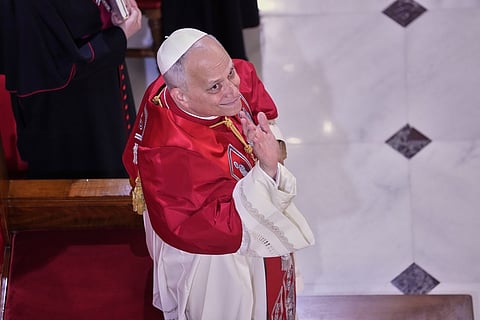Pope’s Iznik pilgrimage revives legacy of the Nicene Creed
Visit highlights enduring power of the creed that continues to shape Christian identity

When Pope Leo XIV arrives in Iznik, the quiet lakeside town southeast of Istanbul, he will be stepping onto one of the most consequential stages in Christian history. Iznik — known in Roman times as Nicaea — is the site where early Christian bishops met in 325AD for the First Council of Nicaea, a gathering that produced what would become the Nicene Creed, the most enduring declaration of Christian faith. Seventeen centuries later, the American pontiff’s pilgrimage with Ecumenical Patriarch Bartholomew I is no mere ceremonial stop: it is an acknowledgment that the debates, divisions and aspirations that shaped the creed remain deeply relevant to a fractured world.
This year’s commemoration marks the 1,700th anniversary of that landmark council, held under the patronage of Emperor Constantine. The First Council of Nicaea was unprecedented in scale — at least 250 bishops from across the Roman Empire convened to settle theological disputes and articulate a shared statement of belief. It was here that the first form of the Nicene Creed was produced, a text that millions of Christians still recite weekly.
Today, the same stones of Nicaea’s ancient basilica will host Pope Leo XIV and Patriarch Bartholomew in joint prayer — an image rich in symbolic power. “When the world is troubled and divided by conflict and antagonism, our meeting with Pope Leo XIV is especially significant,” Bartholomew said in an interview. “It reminds our faithful that we are more powerful and more credible when we are united in our witness and response to the challenges of the contemporary world.”
Iznik and the Nicene Creed
Iznik, known as Nicaea in Roman times, is the town where the First Council of Nicaea was convened in 325 AD under Emperor Constantine.
The council brought together at least 250 bishops from across the Roman Empire in an unprecedented early Christian gathering.
Its outcome was the first version of the Nicene Creed, a statement of faith that millions of Christians still recite each Sunday.
The site of the council is today marked by the ruins of a fourth-century basilica, built about 50 years after the gathering.
Iznik remains a spiritual landmark for Christians, marking the place where early doctrinal disputes were settled and Christian belief was first systematically defined.
A pilgrimage for unity
The Pope’s journey to Iznik sits at the heart of his six-day visit to Turkey and Lebanon, in which he has repeatedly called for Christian unity and peace in a world scarred by war. Earlier in Ankara, he urged President Recep Tayyip Erdogan to embrace Turkey’s potential as a bridge-builder, saying, “This land is inextricably linked to the origins of Christianity, and today it beckons the children of Abraham and all humanity to a fraternity that recognises and appreciates differences.”
In Istanbul he encouraged Turkey’s small Catholic community to embrace hope despite its modest numbers, telling them: “The Church in Turkey is a small community, yet fruitful,” and urging “special attention” toward migrants and refugees — nearly three million of whom remain in the country. “The significant presence of migrants and refugees in this country presents the Church with the challenge of welcoming and serving some of the most vulnerable,” he said.
A town that shaped the Christian world
Iznik itself remains a place where layers of history sit in quiet conversation. Once a thriving Roman and Byzantine city, it hosted theological debates that defined early Christianity — and later, centuries of decline, conquest, and cultural reinvention. Some local residents welcome the revival of interest that accompanies a papal visit.
“Iznik’s deep historical and spiritual significance for Christians” is acknowledged by residents like Suleyman Bulut. But others, like Hasan Maral, admit unease: “The pope coming here feels contradictory to my faith,” he said.
Yet the Pope’s visit underscores that Nicaea’s legacy belongs not only to Christians but to the shared global story of religious development and human intellectual heritage.
The Nicene Creed: A statement that endured empires
The Nicene Creed was far more than a theological compromise. It was the early Church’s attempt to craft unity out of fragmentation. At a time when the empire was divided by doctrinal disputes — most notably over the nature of Christ’s divinity — the bishops at Nicaea sought clarity, universality, and cohesion. Their statement was adopted across the Christian world and, despite later revisions, remains a defining expression of faith in Catholic, Orthodox, and many Protestant churches.
The creed endures because it does more than outline beliefs — it anchors identity. It articulates a shared understanding of God, Christ, and salvation that has survived empires, schisms, and reformations.
That the Pope and the Ecumenical Patriarch — leaders of churches separated since the Great Schism of 1054 — should gather at its birthplace is laden with symbolism.
A creed for a conflicted century
Pope Leo XIV has woven the language of unity, fraternity, and peace throughout his trip, repeatedly invoking the plight of Ukraine and Gaza. His pilgrimage to Nicaea becomes, therefore, not only a tribute to Christian history but a call to live out its principles in the present.
A moment 1,700 years in the making
Seventeen centuries after the bishops of the ancient world gathered to forge a common creed, their spiritual heirs stand together once again in the place where it all began. Iznik may be quiet today, but in the unfolding of Christian history, it remains a crossroads — a reminder that unity, however distant, is not an impossible dream.
As Patriarch Bartholomew said, the meeting “reminds our faithful that we are more powerful and more credible when we are united”. In Iznik, where the Nicene Creed was born, that reminder resonates across the centuries.
- with inputs from AFP and AP
Sign up for the Daily Briefing
Get the latest news and updates straight to your inbox




